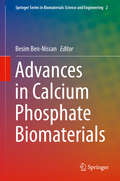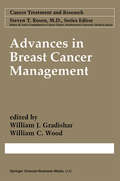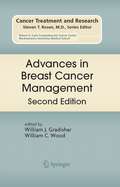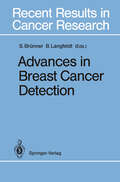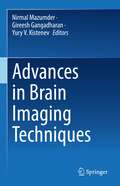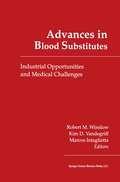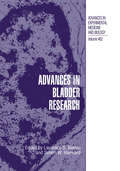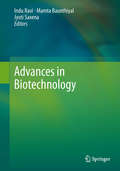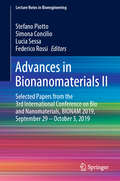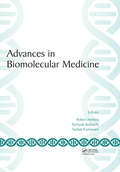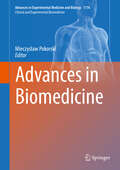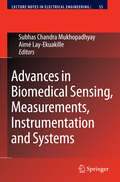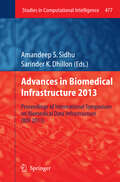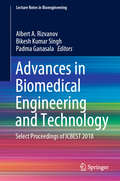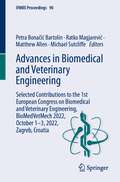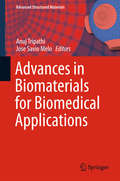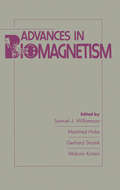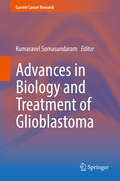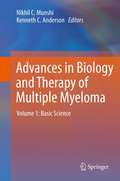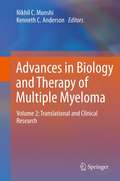- Table View
- List View
Advances in Calcium Phosphate Biomaterials (Springer Series in Biomaterials Science and Engineering #2)
by Besim Ben-NissanAdvances in Calcium Phosphate Biomaterials presents a comprehensive, state-of-the-art review of the latest advances in developing calcium phosphate biomaterials and their applications in medicine. It covers the fundamental structures, synthesis methods, characterization methods, and the physical and chemical properties of calcium phosphate biomaterials, as well as the synthesis and properties of calcium phosphate-based biomaterials in regenerative medicine and their clinical applications. The book brings together these new concepts, mechanisms and methods in contributions by both young and “veteran” academics, clinicians, and researchers to forward the knowledge and expertise on calcium phosphate and related materials. Accordingly, the book not only covers the fundamentals but also open new avenues for meeting future challenges in research and clinical applications.Besim Ben-Nissan is a Professor of Chemistry and Forensic Science at the University of Technology, Sydney, Australia
Advances in Breast Cancer Management, 2nd edition (Cancer Treatment and Research #103)
by William C. Wood William J. GradisharThe optimal management of breast cancer patients relies on the expertise of a team of medical specialists including radiologists, surgeons, radiation therapists and medical oncologists. Much of the progress in breast cancer management made over the last several years reflects the translation of observations made in the laboratory to the clinic. Critically evaluating the impact of new treatment approaches relies on a commitment to well-designed clinical trials. In this volume, Advances in Breast Cancer Management, a renowned group of breast cancer experts have been asked to provide their perspective on management issues that directly effect patients on a day-to-day basis. Dr. Melody Cobleigh discusses the consequences of estrogen deprivation and the ways of ameliorating secondary symptoms and the potential long-term morbidity. Drs. Haigh and Guiliano review the sentinel lymph node biopsy technique including results from their extensive experience. Dr. Abram Recht places into perspective the potential benefit of post-mastectomy radiotherapy and reviews recent trials that address this issue. Dr. Dennis Slamon takes from us from the laboratory to the clinic in explaining the development of Herceptin as a paradigm for therapy targeted to specific molecular characteristics of breast cancer tumor cells. Drs. Nieto, Shpall, Crump and Pritchard offer different perspectives on the future of high-dose chemotherapy with stem cell transplantation as a treatment for breast cancer patients. Drs.
Advances in Breast Cancer Management (Cancer Treatment and Research #141)
by William J. Gradishar William C. WoodThis volume highlights many of the important advances that have improved our understanding of the biology and therapeutics of breast cancer. The initial discussion focuses on the evolving understanding of the genetics of breast cancer. In addition to the well known genetic mutations BRCA1 and BRCA2, other mutations that have recently been identified are discussed.
Advances in Breast Cancer Detection (Recent Results in Cancer Research #119)
by BentLangfeldt SamBrünnerAdvances in Brain Resuscitation
by H. Takeshita B. K. Siesjö J. D. MillerBrain resuscitation is the therapeutic intervention for critically ill patients with severe brain damage, particularly the types caused by ischemia and hypoxia. The The objective of the International Symposium on Brain Resuscitation held in Ube, Yamaguchi Japan October 31 to November 2 1988, and sponsored by Yamaguchi University and the Japanese Ministry of Education, was to review our recent progress in brain resuscitation and to discuss controversies both basic and clinical. To my knowledge, this symposium was the first held in Japan. Our understanding of neuronal dysfunction due to ischemic/hypoxic insults at organ, cellular, and molecular levels has advanced significantly in the last two decades. We had therefore intended that this international symposium should broadly cover the topics which are of interest to both basic researchers and clinicians. Three hundred and twenty-five attendants, including twenty scientists from eight different countries, actively participated in discussion and exchange of new ideas and thoughts concerning brain resuscitation. This book comprises the re ports presented during the symposium which consisted of two main parts: basic and clinical. Although one single meeting can never be expected to solve any problems, meetings often highlight areas of ignorance and problems which are ripe for solving. It has been hard to review all the papers because of the multi plicity of the discussed topics, but the overview on brain resuscitation by Profes sor Bo K. Siesjo and the summary by Professor J.
Advances in Brain Imaging Techniques
by Nirmal Mazumder Gireesh Gangadharan Yury V. KistenevThe book reviews the recent developments in brain imaging and their technological advancements to understand molecular mechanisms associated with neurological disorders and basic behaviors in humans and rodents at the structural, molecular, and functional levels. It discusses the usefulness of advanced optical microscopy techniques, including optical coherence tomography (OCT), miniscope, multiphoton fluorescence (2PF & 3PF), adaptive optics, harmonic generation, and Raman microscopy for understanding pathomechanism of brain disorders and pathological and physiological changes associated with neurodegenerative diseases. Also, the book presents conventional imaging modalities, including Magnetic Resonance Imaging (MRI), for delineating underlying mechanisms and precise early diagnosis of neurological disorders. This book is a useful resource for neuroscientists and researchers working in biomedical engineering and optics.
Advances in Blood Substitutes: Industrial Opportunities and Medical Challenges (Advances In Blood Substitutes Ser. #Vol. 3)
by R. WinslowEach chapter of this volume is a contribution from an expert in the field, chosen by the editors to contribute to the 1997 "Current Issues in Blood Substitute Research and Development" course given in San Diego, March 17-19. The contributors were selected because of their expertise in areas which the editors believe to be critical to the advancement of the field, and which reflect activity in "hot" areas of relevant research. While there is a continuity in style for the annual course, each year brings changes in emphasis and content. In previous years, we were often not able to provide time for participants to present their views and opinions. Consequently, this year we encouraged discussion after each presentation. These sessions were recorded, transcribed, and are printed with the chapters herein. We believe that the product is very close to the capturing this year's course in print, and trust readers will enjoy reading the always candid and often provocative remarks from the audience. The price paid for inclusion of the discussion transcriptions was a delay in publication. Each author was allowed to edit his/her discussion section as well as the final version of the chapters prior to publication. The changes are mainly for grammar, and we tried, when possible, not to alter the conversational style of these interchanges.
Advances in Bladder Research (Advances in Experimental Medicine and Biology #462)
by Laurence S. Baskin Simon W. HaywardThe aim of Bladder Research Congress, San Francisco, California, April 23-25, 1998, was to provide a forum for authoritative investigators who are actively involved in the various disciplines which define the leading edges of bladder research. It is important for such investigators to continue to meet regularly for the purpose of discussing the latest developments in their individual fields, to analyze the significance of current research, to discuss new tactics for unresolved problems, to critically evaluate current theories, and to develop new theories and approaches as needed. The two and a half day meeting was organized into five half day sessions, with each session encompassing one of five topics: (1) Epithelial-Mesenchymal Interactions; (2) Ex tracellular Matrix and Muscle; (3) Nerves and Pharmacology; (4) Infection and Immunol ogy; and (5) Oncology. Each session was introduced by a moderator followed by five to six invited expert speakers with time for extensive interaction from the participants. Two late-afternoon poster sessions allowed further interactions between investigators. This book documents the proceedings of the Bladder Research Congress. It is organ ized into the five half-day sessions of the meeting with moderators overview and an edited transcription of discussions that followed each presentation. I would like to thank Sarah Burke and the Office of Continuing Medical Education, USCF; Joanne Hayward, Editorial Assistant; and Miriam Escamilla, Administrative Assis tant. I hope you find this resource useful. Laurence S. Baskin, M.D.
Advances in Biotechnology
by Indu Ravi Mamta Baunthiyal Jyoti SaxenaThe book “Advances in Biotechnology” is about recent advances in some of the important fields that are ongoing in certain biotechnological applications. Biotechnology has been quite helpful in keeping pace with the demands of every increasing human population and in improving the quality of human life. Major biotechnological achievements associated with human welfare have been from the fields like genetic engineering; transgenic plants and animals; genomics, proteomics, monoclonal antibodies for the diagnosis of disease, gene therapy etc. Fourteen authoritative chapters written by experts having experience in academics and research on current developments and future trends in biotechnology have been empathized. The book provides a detailed account of various methodologies used in biotechnology i.e. High capacity vectors, DNA sequencing dealing with next generation sequencing, Molecular markers, DNA microarray technology, as well as Proteomics that have revolutionized biotechnology with a wide array of applications. The book not only presents a well-founded explanation of the topics but also aims to present up-to-date reviews of current research efforts, some thoughtful discussions on the potential benefits and risks involved in producing biotechnological products and the challenges of bringing such products to market. It will prove to be an excellent reference work for both academicians and researchers, indicating new starting points to young researchers for new projects in the field. The book is intended for biotechnologist, biologist, researchers, teachers and students of Biosciences and Biotechnology.
Advances in Bionanomaterials II: Selected Papers from the 3rd International Conference on Bio and Nanomaterials, BIONAM 2019, September 29 – October 3, 2019 (Lecture Notes in Bioengineering)
by Stefano Piotto Simona Concilio Lucia Sessa Federico RossiThis book presents multidisciplinary research focusing on the analysis, synthesis, and design of bio and nanomaterials. Merging biophysics, biochemistry, and bioengineering perspectives, it discusses the basic properties of materials and their interaction with biological systems; the development of new medical devices, such as implantable systems; and new algorithms and methods for modeling the mechanical, physical, and biological properties of biomaterials. The book gathers the proceedings of the 3rd International Conference on Bio and Nanomaterials, held on September 29–October 3, 2019, on an MSC cruise ship navigating the Mediterranean Sea. It particularly highlights Horizon 2020 projects, covering topics such as novel synthetic strategies for nanomaterials, the implementation of bio- and smart materials for pharmacological and medical purposes, as well as environmental applications. Intended for a broad audience of academics and professionals, it offers a comprehensive and timely snapshot of the field of biomaterials. In addition to a set of innovative theories together with the necessary practical tools for their implementation, it also addresses the current challenges in the field, fostering new discussions and possible future collaborations between diverse groups.
Advances in Biomolecular Medicine: Proceedings of the 4th BIBMC (Bandung International Biomolecular Medicine Conference) 2016 and the 2nd ACMM (ASEAN Congress on Medical Biotechnology and Molecular Biosciences), October 4-6, 2016, Bandung, West Java, Indonesia
by Robert HofstraAdvances in Biomolecular Medicine contains the selected papers presented at the 4th BIBMC (Bandung International Biomolecular Medicine Conference) and the 2nd ACMM (ASEAN Congress on Medical Biotechnology and Molecular Biosciences), hosted by the Faculty of Medicine, Padjadjaran University, Bandung, West Java, Indonesia, 4-6 October 2016. In line with the United Nations Sustainable Development Goals, the theme of the joint scientific meeting is ‘Medical innovation & translational research to ensure healthy lives & promote well-being for all at all ages’. Authors include scientists, academics, practitioners, regulators and other key individuals with expertise and experience relevant to biomolecular medicine, medical biotechnology and molecular biosciences. Topics of the papers cover various aspects of infection, oncology, tuberculosis, genetics, thalassemia, nutrition, cardiovascular, wound healing and endocrinology. This book is essential reading for academics, scientist, practitioners and regulators involved in the area of biomolecular medicine, medical biotechnology and molecular biosciences.
Advances in Biomolecular Medicine: Proceedings of the 4th BIBMC (Bandung International Biomolecular Medicine Conference) 2016 and the 2nd ACMM (ASEAN Congress on Medical Biotechnology and Molecular Biosciences), October 4-6, 2016, Bandung, West Java, Indonesia
by Robert Hofstra Noriyuki Koibuchi Suthat FucharoenAdvances in Biomolecular Medicine contains the selected papers presented at the 4th BIBMC (Bandung International Biomolecular Medicine Conference) and the 2nd ACMM (ASEAN Congress on Medical Biotechnology and Molecular Biosciences), hosted by the Faculty of Medicine, Padjadjaran University, Bandung, West Java, Indonesia, 4-6 October 2016. In line with the United Nations Sustainable Development Goals, the theme of the joint scientific meeting is ‘Medical innovation & translational research to ensure healthy lives & promote well-being for all at all ages’. Authors include scientists, academics, practitioners, regulators and other key individuals with expertise and experience relevant to biomolecular medicine, medical biotechnology and molecular biosciences. Topics of the papers cover various aspects of infection, oncology, tuberculosis, genetics, thalassemia, nutrition, cardiovascular, wound healing and endocrinology. This book is essential reading for academics, scientist, practitioners and regulators involved in the area of biomolecular medicine, medical biotechnology and molecular biosciences.
Advances in Biometrics: Modern Methods and Implementation Strategies
by G. R. SinhaThis book provides a framework for robust and novel biometric techniques, along with implementation and design strategies. The theory, principles, pragmatic and modern methods, and future directions of biometrics are presented, along with in-depth coverage of biometric applications in driverless cars, automated and AI-based systems, IoT, and wearable devices. Additional coverage includes computer vision and pattern recognition, cybersecurity, cognitive computing, soft biometrics, and the social impact of biometric technology. The book will be a valuable reference for researchers, faculty, and practicing professionals working in biometrics and related fields, such as image processing, computer vision, and artificial intelligence.Highlights robust and novel biometrics techniquesProvides implementation strategies and future research directions in the field of biometricsIncludes case studies and emerging applications
Advances in Biomedicine (Advances in Experimental Medicine and Biology #1176)
by Mieczyslaw PokorskiThis book gathers multidisciplinary articles that present advances of our understanding of diseases and the effective treatment of patients. The authors share recent clinical and experimental research findings, highlighting poorly understood areas with uncertain treatment outcomes, such as giant-cell bone tumors and their propensity to metastasize to the lungs; subterranean rehabilitation in pulmonary disorders; male reproductive hormone regulation during physical exercise in hyperbaric, hyperoxic environments, like underwater diving; and amelioration of cognitive decline owing to increased cerebral blood transit time after internal carotid artery stenting. Other topics include new concepts and innovations in the treatment of diabetes in pregnancy, and leg ulcers in chronic venous insufficiency, as well as molecular research on the toxic effects of oxidative stress, impaired cell autophagy, and experimental conditions resembling air pollution. Featuring the latest interdisciplinary advances in biomedicine, this book is a valuable resource for medical professionals, both academics and practitioners, and all allied health-care workers.
Advances in Biomedical Sensing, Measurements, Instrumentation and Systems (Lecture Notes in Electrical Engineering #55)
by Aimé Lay-EkuakilleAdvances in technological devices unveil new architectures for instrumentation and improvements in measurement techniques. Sensing technology, related to biomedical aspects, plays a key role in nowadays applications; it promotes different advantages for: healthcare, solving difficulties for elderly persons, clinical analysis, microbiological characterizations, etc.. This book intends to illustrate and to collect recent advances in biomedical measurements and sensing instrumentation, not as an encyclopedia but as clever support for scientists, students and researchers in other to stimulate exchange and discussions for further developments.
Advances in Biomedical Infrastructure 2013: Proceedings of International Symposium on Biomedical Data Infrastructure (BDI 2013) (Studies in Computational Intelligence #477)
by Amandeep S. Sidhu Sarinder K. DhillonCurrent Biomedical Databases are independently administered in geographically distinct locations, lending them almost ideally to adoption of intelligent data management approaches. This book focuses on research issues, problems and opportunities in Biomedical Data Infrastructure identifying new issues and directions for future research in Biomedical Data and Information Retrieval, Semantics in Biomedicine, and Biomedical Data Modeling and Analysis. The book will be a useful guide for researchers, practitioners, and graduate-level students interested in learning state-of-the-art development in biomedical data management.
Advances in Biomedical Engineering and Technology: Select Proceedings of ICBEST 2018 (Lecture Notes in Bioengineering)
by Albert A. Rizvanov Bikesh Kumar Singh Padma GanasalaThis book comprises select peer-reviewed papers presented at the International Conference on Biomedical Engineering Science and Technology: Roadway from Laboratory to Market (ICBEST 2018) organized by Department of Biomedical Engineering, National Institute of Technology Raipur, Chhattisgarh, India. The book covers latest research in a wide range of biomedical technologies ranging from biomechanics, biomaterials, biomedical instrumentation to tele-medicine, internet of things, bioinformatics, medical signal and image processing. The contents aim to bridge the gap between laboratory research and feasible market products by identifying potential technologies to enhance functionalities of diagnostic and therapeutic devices. The book will be of use to researchers, biomedical engineers, as well as medical practitioners.
Advances in Biomedical and Veterinary Engineering: Selected Contributions to the 1st European Congress on Biomedical and Veterinary Engineering, BioMedVetMech 2022, October 1–3, 2022, Zagreb, Croatia (IFMBE Proceedings #90)
by Petra Bonačić Bartolin Ratko Magjarević Matthew Allen Michael SutcliffeThis book gathers selected peer-reviewed contributions to the 1st European Congress on Biomedical and Veterinary Engineering, BioMedVetMech 2022, held on October 1–3, 2022, in Zagreb, Croatia. It offers a timely snapshot of research findings and advances technologies in the area of biomechanics, rehabilitation and surgery. It covers applications of brain-computer interface, virtual reality and functional electrical stimulation, among others.
Advances in Biomaterials for Biomedical Applications (Advanced Structured Materials #66)
by Anuj Tripathi Jose Savio MeloThis book highlights recent advances in the field of biomaterials design and the state of the art in biomaterials applications for biomedicine. Addressing key aspects of biomaterials, the book explores technological advances at multi-scale levels (macro, micro, and nano), which are used in applications related to cell and tissue regeneration. The book also discusses the future scope of bio-integrated systems. The contents are supplemented by illustrated examples, and schematics of molecular and cellular interactions with biomaterials/scaffolds are included to promote a better understanding of the complex biological mechanisms involved in material-to-biomolecule interactions. The book also covers factors that govern cell growth, differentiation, and regeneration in connection with the treatment and recovery of native biological systems. Tissue engineering, drug screening and delivery, and electrolyte complexes for biomedical applications are also covered in detail. This book offers a comprehensive reference guide for multi-disciplinary communities working in the area of biomaterials, and will benefit researchers and graduate students alike.
Advances in Biomaterials
by Stuart M. LeeThis book discusses advanced instrumental techniques for the rapid bioassay of toxic materials, creep analysis of Delrin stents in cardiac bioprosthesis devices using finite element analysis, and the potential use of electron spectroscopy for chemical analysis for study of biomaterial surface.
Advances in Biomaterials
by Stuart M. LeeThis book discusses advanced instrumental techniques for the rapid bioassay of toxic materials, creep analysis of Delrin stents in cardiac bioprosthesis devices using finite element analysis, and the potential use of electron spectroscopy for chemical analysis for study of biomaterial surface.
Advances in Biology and Treatment of Glioblastoma (Current Cancer Research)
by Kumaravel SomasundaramThis volume covers the most important areas of glioblastoma – surgical resection, molecular pathology, targeted therapies, cancer stem cells, the role of DNA methylation, targeted sequencing for personalized therapy, animal models and advances in pediatric glioblastoma. Chapter authors are junior and senior investigators, who are well established in their particular areas and include neurosurgeons, neuropathologists, neurooncologists and basic scientists.
Advances in Biology and Therapy of Multiple Myeloma: Volume 1: Basic Science
by Nikhil C. Munshi and Kenneth C. AndersonDespite the advances in conventional, novel agent and high dose chemotherapy multiple myeloma (MM) remains incurable. In order to overcome resistance to current therapies and improve patient outcome, novel biologically-based treatment approaches are being developed. Current translational research in MM focusing on the development of molecularly-based combination therapies has great promise to achieve high frequency and durable responses in the majority of patients. Two major advances are making this goal possible. First, recent advances in genomics and proteomics in MM have allowed for increased understanding of disease pathogenesis, identified novel therapeutic targets, allowed for molecular classification, and provided the scientific rationale for combining targeted therapies to increase tumor cell cytotoxicity and abrogate drug resistance. Second, there is now an increased understanding of how adhesion of MM cells in bone marrow (BM) further impacts gene expression in MM cells, as well as in BM stromal cells (BMSCs). As a result of these advances in oncogenomics on the one hand and increased understanding of the role of the BM in the pathogenesis of MM on the other, a new treatment paradigm targeting the tumor cell and its BM microenvironment to overcome drug resistance and improve patient outcome has now been developed. Thalidomide, lenalidomide, and Bortezomib are three agents which target the tumor cell in its microenvironment in both laboratory and animal models and which have rapidly translated from the bench to the bedside. Ongoing efforts are using oncogenomics and cell signaling studies to identify next generation of therapies in MM on the one hand, and to inform the design of combination trials on the other. This new paradigm for overcoming drug resistance and improving patient outcome in MM has great promise not only to change the natural history of MM, but also to serve as a model for targeted therapeutics directed to improve outcome of patients with MM.
Advances in Biology and Therapy of Multiple Myeloma: Volume 2: Translational and Clinical Research
by Nikhil C. Munshi and Kenneth C. AndersonDespite the advances in conventional, novel agent and high dose chemotherapy multiple myeloma (MM) remains incurable. In order to overcome resistance to current therapies and improve patient outcome, novel biologically-based treatment approaches are being developed. Current translational research in MM focusing on the development of molecularly-based combination therapies has great promise to achieve high frequency and durable responses in the majority of patients. Two major advances are making this goal possible. First, recent advances in genomics and proteomics in MM have allowed for increased understanding of disease pathogenesis, identified novel therapeutic targets, allowed for molecular classification, and provided the scientific rationale for combining targeted therapies to increase tumor cell cytotoxicity and abrogate drug resistance. Second, there is now an increased understanding of how adhesion of MM cells in bone marrow (BM) further impacts gene expression in MM cells, as well as in BM stromal cells (BMSCs). As a result of these advances in oncogenomics on the one hand and increased understanding of the role of the BM in the pathogenesis of MM on the other, a new treatment paradigm targeting the tumor cell and its BM microenvironment to overcome drug resistance and improve patient outcome has now been developed. Thalidomide, lenalidomide, and Bortezomib are three agents which target the tumor cell in its microenvironment in both laboratory and animal models and which have rapidly translated from the bench to the bedside. Ongoing efforts are using oncogenomics and cell signaling studies to identify next generation of therapies in MM on the one hand, and to inform the design of combination trials on the other. This new paradigm for overcoming drug resistance and improving patient outcome in MM has great promise not only to change the natural history of MM, but also to serve as a model for targeted therapeutics directed to improve outcome of patients with MM.
